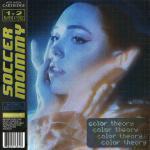
Soccer Mommy color theory
(Loma Vista Recordings)
There’s something endlessly captivating about using light, upbeat melodies and colorful imagery to display your inner darkness. The juxtaposition is almost like dramatic currents in a comedy, where you’ve been disarmed by the brightness to point where the heavy moments hit harder. That’s the experience of listening to color theory. Soccer Mommy’s second album is equal parts buoyant, earworm riffs and gut punches. It’s also an improvement over her already-fantastic debut.
The melancholy vibes are distilled wonderfully in circle the drain, a title that summarizes the album as a whole. Sophie Allison turns what sounds like a prototypical 90s indie guitar riff into something taut and spindly. “Hey, I've been falling apart these days,” she sings wearily, feeling herself endlessly pulled further down by the “mold in my brain.” Centered on Allison’s depressive episodes, the song gets across that feeling of wearing a strong face while slowly collapsing. bloodstream is just as impactful, with Allison singing “Happiness is like a firefly on summer evenings/Feel it slipping through my fingers” over a mix of fuzzy guitar chords and metallic-sounding piano keys.
Color theory is split into three sections, with each color representing a different mood. The blue opening looks at depression and isolation, the yellow middle sings of anxiety and illness, and the gray closes with death and loss. This device helps give the album further focus and understanding of Allison’s emotions.
Royal screw up and night swimming look at the effect Allison’s depression has on her own well-being as well as the people around her. Over the gentle strums of the former, she becomes an anti-fairy tale, giving herself harmful labels like “the princess of screwin' up” and “’fake it 'til you make it’ in a can.” She looks for solutions, but knows it’s not so simple. On the latter, a partner gives up on her when she needs them the most. “You watched me sink beneath the water like a stone/And then let go,” she sings, over layered guitar work. Up the walls tackles another relationship, this time where Allison feels like she’s letting her partner down with her anxiety. Over a tense riff, she tragically sings, “I'm scared the girl you love is hardly ever here at all.”
Sometimes the impact of Allison’s depression and anxiety is the target it paints on her back for others to take advantage of her. On stain, she sings, “I hate the things/That get trapped inside my throat/How you made me feel/With your words like chloroform,” her guitar sounding bleak and broken, like a stripped-back Nine Inch Nails songs from The Fragile.
But color theory is about more than just the effects of Allison’s emotional state. She also does a deep dive into the causes behind the darkness. Lucy expresses Allison’s frustration over compromising her morals within the music industry, the constant feeling of being at odds with herself just to exist as an artist. With the most discordant, and one of the catchiest, riffs on the album, she turns her conflict into the embodiment of Lucifer, temping and taunting with the concessions she must make.
The centerpiece of the album, yellow is the color of her eyes, explores her mother’s terminal illness through a papered-over sense of serenity. Echoing guitars sparkle like a setting sun over a beach, with little touches percolating throughout the song. But the calm that Allison creates is one of resignation, rather than peace or acceptance. “Loving you isn't enough/You'll still be deep in the ground when it's done,” she sings, a devastating line that will reverberate in the bones of anyone who’s lost somebody. As the song ends, the guitar devolves into distortion, the calm slipping into chaos.
The album closes with another reflection on death, gray light. Expanding her musical palette into industrial noises and synth flutes, Allison sees and feels the emptiness of her own inevitable demise. Here, she offers no relief or reassurance, instead leaving us with imagery of drowning. It’s a bleak song but one that powerfully connects. That feeling can summarize color theory as a whole. It’s a heavy, at times uncomfortable listen, but one that feels intensely relatable. It finds strength in the somber and the morose by paining it in bright colors and wonderful riff work. Once you’re drawn in, you won’t want to turn away, no matter how dark the journey becomes. [Believe the Hype]
8 March, 2020 - 20:48 — Joe Marvilli